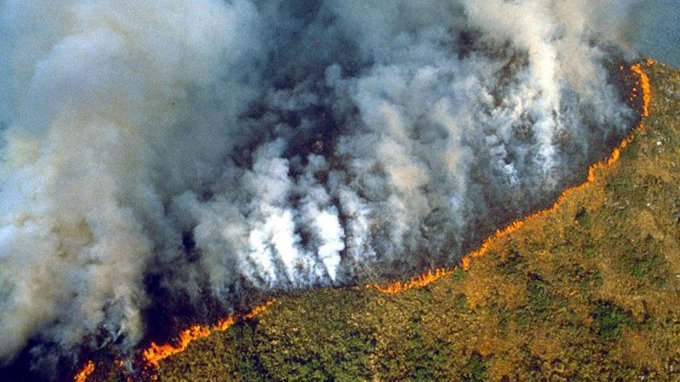
By- Souhardo Chakroborty, Senior Project Officer, Energy & Climate
ICLEI- Local Governments for Sustainability, South Asia


“Nature birthed many children, unfortunately, humans turned into delinquents” – hiraɪ̯θ
The Amazon rainforest has long been recognized as an important repository of biodiversity and natural resources, not only for local people and indigenous communities but also for the rest of the world[1]. There are more than three billion trees, belonging to over 16,000species, in the Amazon rainforest which sequester 25% of the total CO2 stored in the terrestrial environment[2]. Unfortunately, the Amazon rain forests, have continued to disappear over the past several decades. Since the 1970s, 8,00,000 km2 of the Amazon rainforest (an area roughly equal to Rajasthan, Gujarat, and Madhya Pradesh put together) has been lost to ‘development projects’ like farming, dams, logging and road building. Chunks of the Amazon the size of football fields are being cleared every day[3]. According to a recent study, the carbon storage in Amazon has declined by 30% since the 1990s due to higher tree mortality[4]. This implies that the earth’s atmosphere has, since the 1990s, had to deal with 30% more of CO2 than it usually did. CO2 is a greenhouse gas, has thus, contributed to global climate change in a more vigorous manner, owing to the disappearing tree cover in the Amazon rainforest.
Under natural conditions, trees remove CO2 from the atmosphere and absorb it for photosynthesis, an energy-creating process that yields (i) oxygen, which is released back into the air, and (ii) carbon compounds, which helps the trees grow. However, the carbon sequestration process is not just a one-way process. What nature takes, it also gives back, unlike the human species. Owing to the recent widespread Amazon forest fire, huge quantities of the carbon compounds are getting burnt and are being released back to the atmosphere in the form of CO and CO2, with official estimates stating it to be over 200 megatons[5] (1 megaton = 1,000,000 tons = 109kg). Thus, the forest fire is not only adversely affecting the carbon sequestration process but also releasing huge quantities of greenhouse gases back to the atmosphere. The greenhouse gases being released due to the forest fire will, with immediate effect contribute to global climate change, and the diminished sequestration process will ensure that the greenhouse gases continue to contribute to global climate change in an unabated manner in the long term.
On a separate note, it is important to understand the contribution of trees to oxygen circulation. There has been a huge debate over the amount of global oxygen being supplied by the Amazon rainforests. Some experts argue it is 20%, and there are others who beg to differ and state it is less than 10%. Irrespective of the fact how much oxygen is supplied by the three billion trees of Amazon rainforest, it should be noted that even one tree lesser means lesser oxygen supplied to the atmosphere, and lesser carbon being sequestered from the atmosphere, notwithstanding the Amazon forest fire which has burnt down almost 20,000 km2 area. If this area is aggregated into one place then this would roughly equal the area of Meghalayaor Manipur. Imagine a whole state of India burning! Imagine how many trees can be located in that area, and then imagine the damage caused to the global environment. The fires were so intense that smoke could be seen from 2700 km away, which is the length of the Grand Trunk Road that spans between Chittagong and Kabul!
All the forest covers, across the globe, have another important role in the form of regulating the global and regional climate. Water released by plants into the atmosphere through evapotranspiration and to the ocean through the rivers by attracting rain clouds influences world climate and the circulation of ocean currents. This works as a feedback mechanism, as the process also sustains the regional climate on which it depends[6], and the regional climate is ultimately a part of the global climate. Imbalances in any of the regional climatic patterns will have a cascading effect on other regional climatic patterns. This can be understood in simpler terms with the Indian subcontinent’s monsoon phenomena. The monsoon that the subcontinent receives is dependent on the air circulation of the Tibetan Plateau and the ocean circulation off the western coast of the South American continent. The Amazon forest fire has increased the air temperature around South America, consequently hindering the upwelling of warm ocean currents which is one of the prime reasons for monsoons in the Indian subcontinent. Going forward this adverse impact will only increase, giving rise to more incidences of El Nino.
The damage statistics provided till here only considers the climate change perspective, discounting the damage to biodiversity which provides edible, medicinal, recreational products etc to us, or the loss of indigenous lives and livelihoods. Alas! The Amazonians do not have Jake Sully’s Avatar to help them.
It is unfortunate that when the lungs of the earth are burning, countries are busy politicizing the matter. In the past the South American governments had minimal incentive to protect the Amazon rainforests, owing to increasing consumer demand for farmlands, and now even the dialogue for protecting the Amazon will come to an end because there is not much left to protect. There is an increasing worry that this fire would further spread owing to the upcoming dry spell, and these kinds of fires are even more dangerous because they tend to lie close to the earth’s surface making it difficult for aerial surveillance to capture them. In other words, the damage has only begun.
Endnote: Thomas Robert Malthus in 1798 wrote“An Essay on the Principle of Population” which stated that the earth’s population is increasing in geometric progression while its capability to produce food in arithmetic progression. He was denounced by his contemporaries on grounds that Malthus did not consider the human species’ capability to innovate and make technological advances. Herewith the Amazon forest fires, we have an ideal example of what the contemporaries had implied back then. Technology is ensuring farmlands are being created to feed the hungry human populace. Who needs Galactus[7] when we have us!
References-
[1]https://edition.cnn.com/2019/09/04/americas/brazil-amazon-npw-intl/index.html
[2]https://amazonaid.org/trees/
[3]https://www.livemint.com/mint-lounge/features/climate-change-tracker-the-amazon-forest-goes-up-in-smoke-1567152223831.html
[4]https://amazonaid.org/trees/
[5]https://www.bbc.com/news/world-latin-america-49450925
[6]http://wwf.panda.org/knowledge_hub/where_we_work/amazon/about_the_amazon/why_amazon_important/
[7]Galactus is a fictional character from the Marvel Comic Universe who feeds off entire planets, solar systems and galaxies to sustain himself.










Awesome read! Thank you sir.
“It is unfortunate that when the lungs of the earth are burning, countries are busy politicizing the matter.”
Well said…really touched my heart…….wonderful article with relevant information…thankyou for your best effort
Really nice and informative essay…feel really bad for the loss of this integral part of mother nature